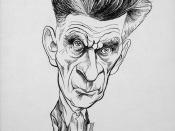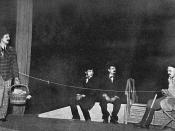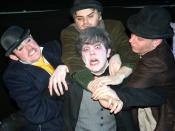Waiting for Godot Samuel Beckett's Waiting for Godot is a mid 20th century play belonging to the genre of the "Theatre of the Absurd", and focusing on the senselessness of the human condition. The idea of the absurd is a major theme in Waiting for Godot and is embodied in its main characters. Estragon (Gogo) and Vladimir (Didi), taken together, represent the universal man facing the world. Beckett uses each character to show the limitations and absurdity of different aspects of human existence. The pair of Vladimir and Estragon exemplifies, in the metaphysical level, the dichotomy of man's nature in body and mind, and illustrates the limitations and senselessness of these parts of human nature.
In Waiting for Godot, Vladimir and Estragon represent the mind/body duality of the human being, a fundamental principle in Western philosophy. Beckett's intention is to demonstrate through these characters the limitations of the mind and body, taken separately or together, which prevent us from coping with our finite being.
In Waiting for Godot Vladimir represents the mind, while Estragon symbolizes the body. "The pair of Vladimir and Estragon represent a sort of Everyman, by embodying complementary aspects of human nature: Vladimir the intellectual side of man, Estragon the corporeal" (Webb, 27). Throughout the story Beckett presented Vladimir as the intellectual who is concerned with various philosophical and theological problems, while Estargon is more concerned with bodily pleasures and materialistic gains. However these two tramps seem to be imperfect individuals or an imperfect pair in contrast to the Western idea of human existence, which views man as able to achieve perfection through the cooperation of the two aspects of human nature.
Beckett used different symbols to reinforce the sense of the mind/body duality in the Vladimir-Estragon pair. "Their names suggest their personalities "...


